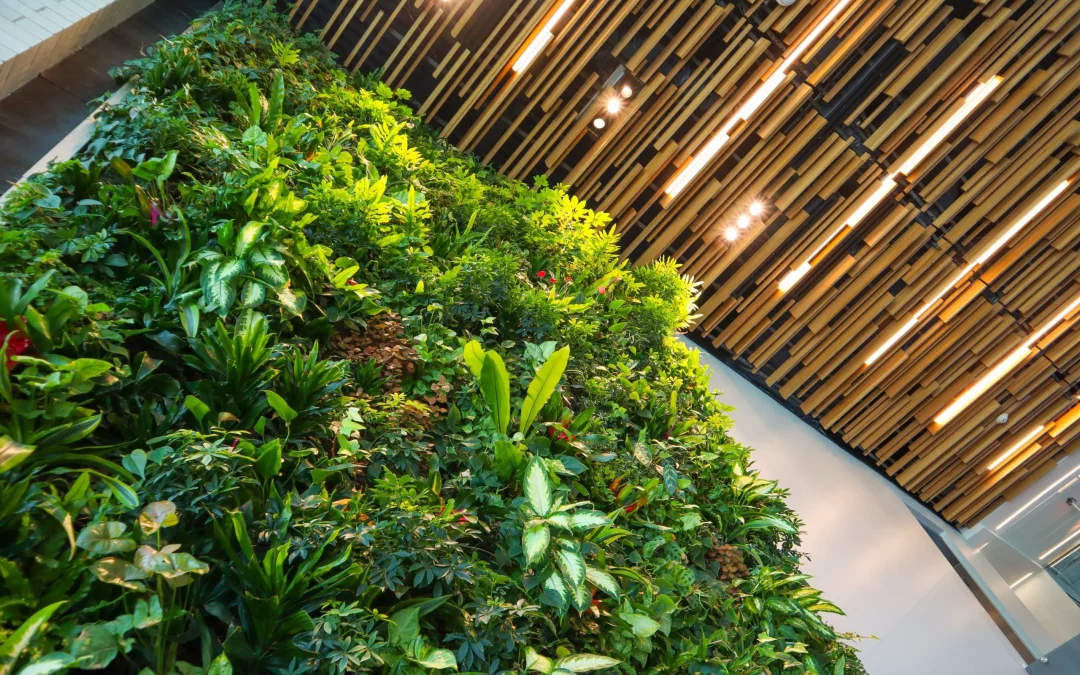Indoor artificial gardens are a fantastic way to incorporate greenery into your home or office without the need for ongoing maintenance. In this article, we’ll discuss what an indoor artificial garden is, how to create one, the pros and cons of having one, and more.
Contents
- 1 What is an Indoor Artificial Garden?
- 2 How to Create Your Own Indoor Artificial Garden
- 3 Pros and Cons of an Indoor Artificial Garden
- 4 Ideas and Themes for Your Indoor Artificial Garden
- 5 Maintaining Your Indoor Artificial Garden
- 6 Additional Ideas for Your Indoor Artificial Garden
- 7 Benefits of an Indoor Artificial Garden for Businesses
- 8 Tips for Choosing High-Quality Artificial Plants
- 9 Custom Indoor Artificial Garden Design Services
- 10 The Future of Indoor Artificial Gardens
What is an Indoor Artificial Garden?
An indoor artificial garden is a designed space that replicates the appearance of a natural garden using artificial plants and other decorative elements. These gardens are ideal for those who love the look of lush greenery but don’t have the time or resources to maintain live plants. Indoor artificial gardens can range from simple arrangements to elaborate, themed installations.
How to Create Your Own Indoor Artificial Garden
Building an indoor artificial garden can be as simple or complex as you’d like. Here are some steps to help you get started:
1. Choose a Space
Find a suitable area in your home or office where you’d like to create the artificial garden. Consider factors like available light, room size, and the overall aesthetic of the space.
2. Select Your Artificial Plants
Choose a variety of artificial plants that complement your space and personal style. Look for high-quality plants that closely resemble their natural counterparts to create a more realistic garden.
3. Plan the Layout
Before you start arranging your artificial plants, plan your garden’s layout. This may involve sketching a design or simply visualizing the placement of the plants. Consider incorporating different plant heights and textures for visual interest.
4. Add Decorative Elements
In addition to artificial plants, consider adding other decorative elements like rocks, mulch, or garden ornaments to enhance the look of your garden.
5. Install Lighting
Proper lighting can make your artificial garden even more attractive. Choose LED lights or fairy lights to create a warm, inviting atmosphere.
Pros and Cons of an Indoor Artificial Garden
Pros
- Low maintenance: Artificial gardens require little to no upkeep compared to live gardens. There’s no need to worry about watering, pruning, or fertilizing your plants.
- Long-lasting: High-quality artificial plants can last for years, making them a cost-effective alternative to live plants.
- Allergy-friendly: Artificial gardens are an excellent option for individuals with plant allergies, as they don’t release pollen or other allergens.
- Versatile: Artificial gardens can be created in any indoor space, regardless of light or temperature conditions.
Cons
- Lack of natural benefits: Artificial plants don’t provide the same air-purifying and stress-relieving benefits as live plants.
- Potential for lower quality: Lower-quality artificial plants may not look as realistic or appealing as their natural counterparts.
- Environmental impact: Some artificial plants are made from non-recyclable materials, which can have a negative impact on the environment.
- Initial cost: High-quality artificial plants can be more expensive upfront compared to live plants, although they typically have lower long-term maintenance costs.
Ideas and Themes for Your Indoor Artificial Garden
To make your indoor artificial garden more visually appealing and engaging, consider incorporating a theme or unique design elements. Here are some ideas to inspire you:
- Tropical paradise: Create a lush, tropical atmosphere with a variety of artificial palm trees, ferns, and flowering plants.
- Zen retreat: Design a calming space with a minimalist layout, incorporating elements like bamboo plants, river rocks, and a small artificial water feature.
- Succulent sanctuary: Build a low-maintenance garden with various artificial succulents and cacti, using different-sized pots and planters for visual interest.
- English cottage: Recreate the charm of a traditional English garden with artificial roses, lavender, and boxwood hedges.
- Vertical garden: Maximize your space by creating a vertical garden with artificial plants, which can be hung on walls or used as room dividers.
Maintaining Your Indoor Artificial Garden
While an indoor artificial garden is low maintenance, it still requires some care to keep it looking its best. Here are a few tips for maintaining your artificial garden:
- Dust regularly: Use a soft cloth, duster, or a hairdryer on a low setting to remove dust and debris from your artificial plants.
- Spot clean: If you notice any stains or dirt on your plants, use a damp cloth and mild soap to gently clean the affected areas.
- Rearrange occasionally: Change up the layout of your garden from time to time to keep it looking fresh and engaging.
- Store properly: If you need to store your artificial plants, place them in a well-ventilated area, away from direct sunlight, to prevent fading or damage.
Additional Ideas for Your Indoor Artificial Garden
To further enhance your indoor artificial garden, consider incorporating some of the following ideas and features:
1. Fairy garden
Craft a whimsical and enchanting space by creating a miniature fairy garden with tiny artificial plants, miniature furniture, and figurines. This can be a great project for children and adults alike.
2. Seasonal decorations
Transform your artificial garden to reflect different seasons or holidays by incorporating seasonal decorations. Add artificial autumn leaves, pumpkins, or Halloween ornaments for a fall-themed garden, or incorporate Christmas lights and ornaments for a festive winter display.
3. Aromatic garden
Even though artificial plants don’t have a natural fragrance, you can still create an aromatic garden experience by incorporating essential oil diffusers or scented candles that mimic the scents of your favorite plants and flowers.
4. DIY planters
Customize your indoor artificial garden by creating your own unique planters. Repurpose household items like old teacups, mason jars, or wooden crates, or get creative with DIY planter ideas to add a personal touch to your garden.
5. Pet-friendly garden
If you have pets, an indoor artificial garden can be a safe and worry-free alternative to live plants, as some plants can be toxic to animals. Choose artificial plants that replicate pet-safe varieties to create a visually appealing and pet-friendly space.
Benefits of an Indoor Artificial Garden for Businesses
An indoor artificial garden isn’t just for homes – it can also benefit businesses in various ways:
- Improved aesthetics: A well-designed artificial garden can enhance the overall appearance of your commercial space, creating a welcoming and professional environment for clients and employees.
- Increased productivity: Research has shown that exposure to natural elements can improve productivity and well-being. While artificial gardens don’t provide the same benefits as live plants, they can still have a positive impact on mood and focus by creating a visually pleasing environment.
- Cost-effective: Compared to maintaining live plants, artificial gardens can be a more cost-effective solution for businesses, especially in large commercial spaces or areas with challenging growing conditions.
- Versatility: Artificial gardens can be tailored to suit any business’s aesthetic and space requirements, making them a versatile option for a variety of industries, including retail, hospitality, and office spaces.
Tips for Choosing High-Quality Artificial Plants
To ensure your indoor artificial garden looks as realistic and appealing as possible, it’s essential to select high-quality artificial plants. Here are some tips for choosing the best artificial plants for your garden:
- Materials: Look for artificial plants made from high-quality materials like silk, plastic, or fabric that closely resemble the texture and appearance of real plants.
- Color: High-quality artificial plants will have natural-looking color variations, with gradients and shades that mimic real foliage.
- Attention to detail: Examine the leaves, stems, and flowers of the artificial plants for realistic details like veins, thorns, or buds.
- UV resistance: If your artificial garden will be exposed to sunlight, look for plants with UV-resistant coatings to prevent fading over time.
- Reviews: Before purchasing artificial plants, read customer reviews and look for recommendations from reputable sources to ensure you’re getting the best quality for your investment.
Custom Indoor Artificial Garden Design Services
If you’re interested in creating a unique and professionally designed indoor artificial garden but don’t have the time or expertise to do it yourself, consider hiring a custom indoor artificial garden design service. These professionals can help you create a stunning, customized garden that suits your space, style, and needs. Here are some benefits of working with a professional design service:
- Expertise: Professional designers have the knowledge and experience to choose the best artificial plants and decorative elements, ensuring your garden looks realistic and cohesive.
- Personalization: Custom design services can tailor the garden to your specific preferences, incorporating your favorite plants, colors, and themes.
- Space planning: Designers can help you optimize your available space, creating a layout that maximizes both function and aesthetics.
- Installation: Many design services also offer installation, taking the hassle out of setting up your indoor artificial garden.
To find a reputable indoor artificial garden design service, search online, ask for recommendations from friends or family, or consult with local garden centers or interior design professionals.
The Future of Indoor Artificial Gardens
As technology continues to advance, the quality and realism of artificial plants are likely to improve, making indoor artificial gardens even more appealing and versatile. Developments in materials, manufacturing techniques, and design trends could lead to new and innovative ways to incorporate artificial greenery into our living and working spaces.
For example, the use of sustainable and eco-friendly materials in artificial plant production could help reduce the environmental impact of these products. Additionally, advances in 3D printing technology could enable the creation of highly realistic, customizable artificial plants tailored to individual preferences and needs.
In conclusion, an indoor artificial garden is an excellent solution for those who desire the beauty and serenity of nature in their living or working environment but don’t have the time or resources to maintain live plants. By selecting high-quality artificial plants, creating a well-planned layout, and incorporating various themes and decorative elements, you can create a visually appealing, low-maintenance garden that suits your personal style and needs.

